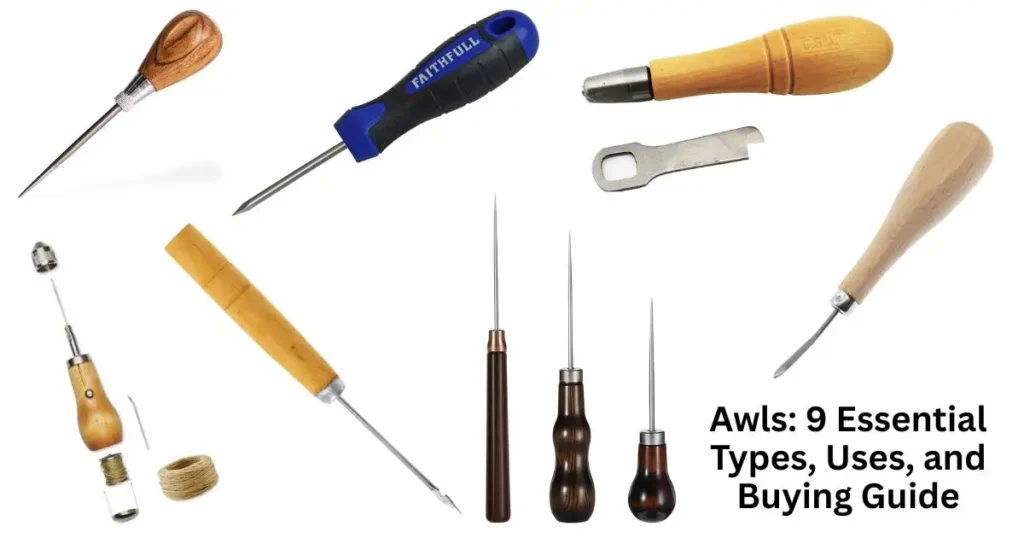The awl tool is a crafting gem, perfect for precise work. What is an awl tool used for? It pierces and marks materials like wood, leather, and fabric. Used for centuries, awls are still essential today. This guide explores nine vital uses of the awl tool. Learn how it shines in woodworking, leatherworking, and more.
Table of Contents
What Is an Awl Tool?
What is an awl tool used for? An awl is a sharp, pointed tool. It has a steel tip and a handle, often wood or plastic. Crafters use it to pierce holes or mark surfaces. Awls ensure accuracy in many projects. Historically, awls date back 77,000 years.
Early humans used bone awls to sew hides. Native Americans crafted moccasins with them. Today, types like scratch awls and stitching awls serve specific tasks.
What is an awl tool used for in sewing?

Awl Tool Uses in Woodworking
Woodworking relies on the awl tool for precision. What is an awl tool used for in wood? It marks and pierces.
Marking and Scribing
Scratch awls scribe wood lines. These lines guide cutting or chiseling. For example, mark a table leg for a perfect cut. This keeps work neat and accurate. The awl tool uses a sharp tip to etch clear lines.
Creating Pilot Holes
Bradawls make pilot holes for screws or nails. This prevents wood from splitting. It’s crucial for delicate projects like cabinetry. A pilot hole ensures screws go in straight. The awl tool uses a chisel-like tip for clean holes. Check out a photo of a bradawl in action.
Awl Tool Uses in Leatherworking
Leatherworking thrives with the awl tool. What is an awl tool used for in leather? It creates holes for stitching and fasteners.
Stitching Holes
Stitching awls pierce leather for hand-sewing. They make even holes for strong seams. For instance, use a Speedy Stitcher to sew a leather belt. The awl tool uses a needle-like tip, often with an eye for thread. This makes stitching smooth and durable. Watch our video on leather stitching.
Fastener Preparation
Hole punch awls create holes for rivets or snaps. These holes secure leather accessories like bags. Diamond awls offer precision for high-end projects. Palm awls handle thick leather, like knife sheaths. The awl tool uses sturdy tips for tough materials.
Awl Tool Uses in Other Crafts and Applications
The awl tool shines beyond wood and leather. What is an awl tool used for in other crafts? It tackles bookbinding, fabrics, and more.
Bookbinding
Hole punch awls pierce paper for bookbinding. They create holes to sew pages together. This ensures strong, lasting books. The awl tool uses a fine tip for delicate work.
Heavy Fabrics and Canvas
Awls punch holes in canvas or heavy fabrics. They’re great for tent or backpack repairs. For example, fix a torn sail with an awl. The awl tool uses a robust tip to handle tough materials.
Bushcraft and DIY
In bushcraft, awls pierce bark for cordage. They mark wood for traps or shelters. A Swiss Army knife awl is perfect for survival tasks. For DIY, awls remove nails or open cans. The awl tool is versatile for emergencies. See our infographic of awl uses.
Comparing Awl Tools to Related Tools
What is an awl tool used for, compared to other tools? Awls differ from similar tools.
- Reamer vs. Awl: Reamers enlarge holes, often in metal. Awls create initial holes in softer materials.
- Auger vs. Awl: Augers bore large, deep holes. Awls make small, precise ones.
- Gimlet vs. Awl: Gimlets bore wood with a screw tip. Awls pierce without boring.
These differences matter. The awl tool uses precision for specific tasks. A comparison chart clarifies these tools.
Choosing and Maintaining an Awl Tool
What is an awl tool used for without proper selection and care? Choose wisely and maintain well.
Selection Tips
Pick an awl based on your craft. For woodworking, try a Stanley 69-122 scratch awl ($8-$12). For leather, use a Speedy Stitcher SEW120 kit ($25-$35). High-carbon steel is sharp but rusts. Stainless steel lasts longer. Ergonomic handles reduce fatigue. The awl tool uses quality materials for the best results.
Maintenance
Sharpen awls with a diamond stone. Apply oil to prevent rust. Store in a sheath for safety. Watch our maintenance tutorial. Limitations: Awls can’t pierce hard metals or dense woods. Use a drill for those. Hand fatigue may occur without ergonomic handles.
Explore our full awl buying guide in Awl Tool: 9 Essential Uses in Crafting and Ultimate Guide.
Conclusion
What is an awl tool used for? It’s a versatile tool for woodworking, leatherworking, bookbinding, and bushcraft. From marking wood to stitching leather, awls deliver precision. Their simple design remains vital today. Try an awl for your next project! Which awl tool will you use? Share in the comments or post on social media.
For more, read Awl Tool: 9 Essential Uses in Crafting and the Ultimate Guide.
Follow Us: Pinterest







